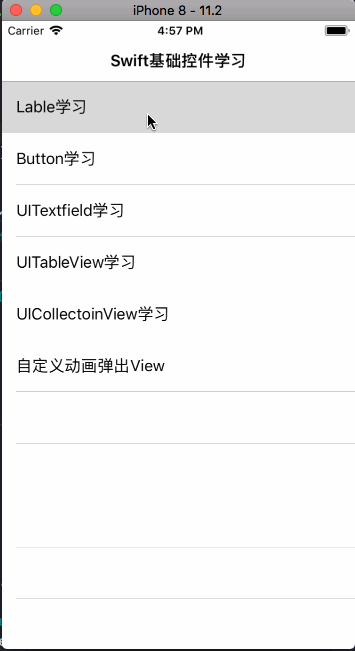一些基本的Swift入门级别的控件使用方法,只适合入门的人看。大神请绕道demo
Label的创建
//一个构造方法
func creatlabel(tittle:String,fontSize:CGFloat ,textAligement:NSTextAlignment, backgroudColor:UIColor,textColor:UIColor,frame:CGRect) {
let label = UILabel.init(frame: frame)
label.font = UIFont.systemFont(ofSize: fontSize)
label.text = tittle
label.textAlignment = textAligement
label.textColor = textColor
label.backgroundColor = backgroudColor
self.view.addSubview(label)
}
// 调用方法创建lable
override func viewDidLoad() {
super.viewDidLoad()
self.view.backgroundColor = UIColor.white
creatlable(tittle: "测试创建Lable", fontSize: 14, textAligement: NSTextAlignment.center, backgroudColor: .red, textColor: .white, frame:CGRect.init(x: (self.view.frame.size.width-200)/2, y: 100, width: 200, height: 45))
}
Button的创建
//一个构造方法
func creatlable(tittle:String,fontSize:CGFloat ,textAligement:NSTextAlignment, backgroudColor:UIColor,textColor:UIColor,frame:CGRect) {
let button = UIButton.init(frame: frame)
button.titleLabel?.font = UIFont.systemFont(ofSize: fontSize)
button .setTitle(tittle, for: UIControlState.normal)
button.titleLabel?.textAlignment = textAligement
button.setTitleColor(textColor, for: .normal)
button.backgroundColor = backgroudColor
button.addTarget(self, action: #selector(tapAction), for: .touchUpInside)
self.view.addSubview(button)
}
//添加方法
override func viewDidLoad() {
super.viewDidLoad()
self.view.backgroundColor = UIColor.white
creatlable(tittle: "测试创建Button", fontSize: 14, textAligement: NSTextAlignment.center, backgroudColor: .red, textColor: .white, frame:CGRect.init(x: (self.view.frame.size.width-200)/2, y: 100, width: 200, height: 45))
}
//点击事件
@objc func tapAction() {
let alert = UIAlertController.init(title: "这是一个button", message: nil, preferredStyle: .actionSheet)
let action = UIAlertAction.init(title: "确定", style: .default) { (action) in
}
let action1 = UIAlertAction.init(title: "取消", style: .cancel) { (action) in
}
alert.addAction(action)
alert.addAction(action1)
self .present(alert, animated: true, completion: nil)
}
UITextField的使用
//懒加载一个UITextField
lazy var textfield: UITextField = {
let textfield = UITextField.init(frame: CGRect.init(x: (self.view.frame.size.width-self.view.frame.size.width*0.8)/2, y: 100, width: self.view.frame.size.width*0.8, height: 45))
textfield.backgroundColor = UIColor.groupTableViewBackground
textfield.placeholder = "这是一个输入框"
textfield.layer.cornerRadius = 5
textfield.font = UIFont.systemFont(ofSize: 12)
textfield.clipsToBounds = true
let image = UIImageView.init(frame: CGRect.init(x: 0, y: 0, width: 25, height: 25))
image.image = UIImage.init(named: "tab_mine_selected@2")
textfield.leftView = image
textfield.leftViewMode = .always
return textfield
}()
//添加UITextField
override func viewDidLoad() {
super.viewDidLoad()
self.view.backgroundColor = UIColor.white
self.view.addSubview(self.textfield)
}
TableViewController的使用
//懒加载一个tableivew
lazy var tableview: UITableView = {
let tableview = UITableView.init(frame: self.view.bounds, style: UITableViewStyle.plain)
tableview.backgroundColor = UIColor.white
tableview.rowHeight = 55
tableview.delegate = self
tableview.dataSource = self
tableview.register(UITableViewCell.self, forCellReuseIdentifier: "cell")
return tableview
}()
//添加和一些代理
override func viewDidLoad() {
super.viewDidLoad()
self.view.backgroundColor = UIColor.white
self.view.addSubview(self.tableview)
}
func numberOfSections(in tableView: UITableView) -> Int {
return 3
}
func tableView(_ tableView: UITableView, numberOfRowsInSection section: Int) -> Int {
return 5
}
func tableView(_ tableView: UITableView, cellForRowAt indexPath: IndexPath) -> UITableViewCell {
let cell = tableview.dequeueReusableCell(withIdentifier: "cell", for: indexPath)
cell.textLabel?.text = (indexPath.row+1).description
return cell
}
func tableView(_ tableView: UITableView, titleForHeaderInSection section: Int) -> String? {
return "这是第"+(section+1).description + "区"
}
CollectionViewController的使用
override func viewDidLoad() {
super.viewDidLoad()
self.view.backgroundColor = UIColor.white
self.view.addSubview(self.collectionview)
}
func collectionView(_ collectionView: UICollectionView, numberOfItemsInSection section: Int) -> Int {
return 20
}
func collectionView(_ collectionView: UICollectionView, cellForItemAt indexPath: IndexPath) -> UICollectionViewCell {
let cell = collectionview.dequeueReusableCell(withReuseIdentifier: "cell", for: indexPath)
cell.backgroundColor = UIColor.red
return cell
}
//懒加载UICollectionView
lazy var collectionview: UICollectionView = {
let flowlayout = UICollectionViewFlowLayout.init()
flowlayout.itemSize = CGSize.init(width: (self.view.frame.size.width-40)/3-20, height: 60)
flowlayout.sectionInset = UIEdgeInsets.init(top: 10, left: 10, bottom: 10, right: 10)
let collection = UICollectionView.init(frame: self.view.bounds, collectionViewLayout: flowlayout)
collection.delegate = self
collection.dataSource = self
collection.backgroundColor = UIColor.white
collection.register(UICollectionViewCell.self, forCellWithReuseIdentifier: "cell")
return collection
}()
自定义view动画弹出
//点击button的调用弹出view方法
@objc func tapAction() {
print("点击弹出动画")
let anition = AnimationVIew.init(frame: self.view.bounds)
anition.show()
}
//自定义view的主要方法
lazy var baseView:UIView = UIView()
//显示
func show() {
UIApplication.shared.keyWindow?.addSubview(self)
self.baseView.transform = CGAffineTransform(scaleX: 0.5, y: 0.5)
self.alpha = 0
UIView.animate(withDuration: 0.3) {
self.baseView.transform = CGAffineTransform(scaleX: 1, y: 1)
self.alpha = 1
}
}
//消失
@objc func hide() {
UIView.animate(withDuration: 0.25, animations: {
self.alpha = 0
}) { (complete) in
self.removeFromSuperview()
}
}
override init(frame: CGRect) {
super.init(frame: frame)
self.backgroundColor = UIColor.groupTableViewBackground
setUpsubviews()
let tapgesture = UITapGestureRecognizer.init(target: self, action: #selector(hide))
self.addGestureRecognizer(tapgesture)
}
func setUpsubviews() {
baseView = UIView.init(frame: CGRect.init(x: (self.frame.size.width-self.frame.size.width*0.8)/2, y: 100, width: self.frame.size.width*0.8, height: 300))
baseView.layer.cornerRadius = 10
baseView.clipsToBounds = true
baseView.backgroundColor = UIColor.red
self.addSubview(self.baseView)
}
